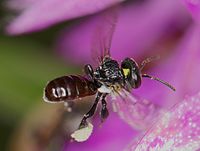
Are strigolactones a key in plant–parasitic nematodes interactions? An intriguing question
Sign Up to like & getrecommendations! Published in 2021 at "Plant and Soil"
DOI: 10.1007/s11104-021-04862-8
Abstract: Background and aims Plant parasitic nematodes (PPNs) are among the most important pests in agriculture. Chemical inputs are widely used for their control; however, the negative impact of these agrochemicals on environmental and human health… read more here.
Keywords: strigolactones key; key plant; plant parasitic; parasitic nematodes ... See more keywords

Interspecific variation in ploidy as a key plant trait outlining local extinction risks and community patterns in fragmented landscapes
Sign Up to like & getrecommendations! Published in 2018 at "Functional Ecology"
DOI: 10.1111/1365-2435.13127
Abstract: 1. Polyploidy is associated with a plethora of phenotypic and genetic changes yielding transformative effects on species' life-history and ecology. These biological attributes can contribute to the ... read more here.
Keywords: interspecific variation; plant trait; key plant; variation ploidy ... See more keywords

Attractiveness of wildflower mixtures for wild bees and hoverflies depends on some key plant species
Sign Up to like & getrecommendations! Published in 2018 at "Insect Conservation and Diversity"
DOI: 10.1111/icad.12264
Abstract: Agricultural intensification is considered to be a major driver of terrestrial biodiversity decline. Resulting loss, isolation and degradation of flower‐rich habitats are threatening pollinators. Agri‐environmental schemes (AES) aim to counteract these negative effects, including measures… read more here.
Keywords: bees hoverflies; seed; wild bees; plant ... See more keywords